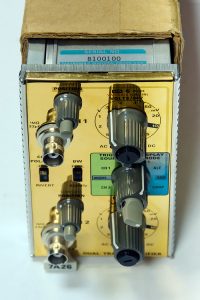This unique 7A26 is not part of the museum exhibit but was brought into the museum by the owner Tom Rousseau. It is the 100,000 7A26 Dual Trace Amplifier plug-in produced and was built with a special gold-plated panel and presented to him.

Tom Rousseau was the designer of a number of very successful products at Tek - the 7A15A, 7A16A, 7A18, 7A24, 7A26, 7854, and 11400. In addition Tom also played key roles in the development of the TDS 400/500 and TDS 3000 series. The 7A26 is the most popular plug-in of all time. Over its life-cycle more than 120,000 were produced. To acknowledge Tom’s achievement Tektronix presented him with a gold plated 7A26 with the serial number of the 100,000th 7A26. It is S/N B100100.
Tom recognized that the left/right mirror symmetry of the 7A12 front panel could be improved considerably. This symmetry requires two unique PC boards which are mirror opposites of each other. That led to extra inventory, assembly problems, and unreliable attenuators. Tom showed that a top/bottom arrangement saved space, cost less to manufacture, required fewer parts, and would be easier to repair.
Tom was asked to design the 7A18 but the 7A26 and other plug-ins were his own concept that he sold to management. Tom Rousseau writes "After the 7A18 project, and becoming familiar with the M84 (155-0078-XX) IC, I conjured up the 7A26 concept based on the general layout of the 7A18. I figured that with the M84, I could more than double the bandwidth of the 7A18 and provide a reasonably higher bandwidth, 1 MΩ dual trace plug-in. Further, I offered the possibility of making four vertical plug-ins from one basic design: 7A26, 7A24 (50 ohm), 7A16A (1 MΩ, single channel) and a fourth not pursued, 7AXX, single channel, 50 Ohm. I worked on this for a while then popped the idea to management (Oliver Dalton), who agreed to three of the plug-ins."
That was one of the great things about Tek back in the early ‘70s … an internal entrepreneurial spirit! The 7A18 had physical characteristics that proved the benefits of over/under layout. It was a huge improvement from a manufacturing, reliability and value point of view over the 7A12. It was followed by the 7A15A and PL-1186 in 1973. After the 7A18 was completed, Tom came up with the idea to extend the physical concept to a higher bandwidth, hence the 7A26 and 7A16A. Given the intrinsic bandwidth of the 7A26 without the input FET impedance converter, a 50 Ohm version could also be made with much higher bandwidth, hence the 7A24 and 7A25. The 7A25 did not make it into production. The 7A24 and 7A26 were introduced in 1974.
Tom’s initial plugin resulted in these plugins based on the simpler top/bottom layout of the 7A18:
- 1MΩ 80MHz Dual Channel plug-in. This is the 7A18.
- 1MΩ 75MHz Single Channel plug-in. This is the 7A15A
- 1MΩ 225MHz Single Channel plug-in. This became 7A16A, which replaced the 7A16 with a new design that did away with the turret attenuator in favor of cam switches.
- 1MΩ 200MHz Dual Channel plug-in. This became the 7A26.
- 50Ω 350MHz Single Channel plug-in. This never went into production, but it was named the 7A25.
- 50Ω 350MHz Dual Channel plug-in. This became the 7A24.
